
by Terri Cook and Lon Abbott Wednesday, June 1, 2016
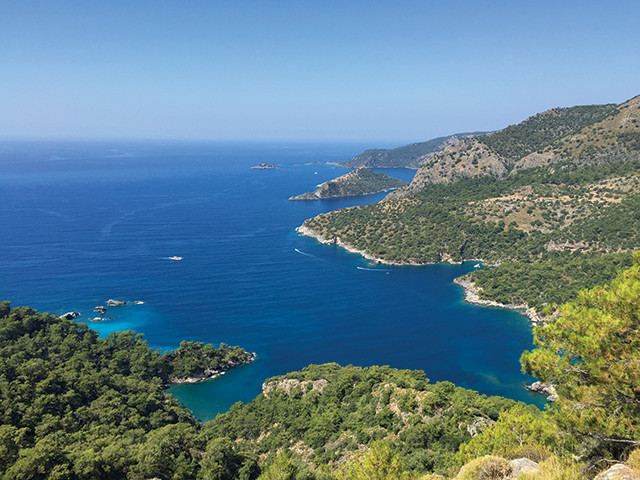
The rugged Taurus Mountains meet the Mediterranean Sea along Turkey's Turquoise Coast. Credit: Terri Cook and Lon Abbott.
We visited Turkey in June 2015, prior to the heightening of the Syrian refugee crisis. At the time, there were few security concerns, but due to recent turmoil, the U.S. Department of State has issued a travel warning encouraging Americans to avoid visiting southeastern Turkey and warning of heightened threats from terrorist groups throughout the country. At press time, none of the areas covered in this article were within the State Department’s advised avoidance area. However, it’s best to frequently check the State Department website (https://travel.state.gov/content/travel/en.html) prior to your trip and sign up for their travel alerts in case additional warnings are posted.
Trip planning in our family of four can be a slightly contentious affair. Two of us love to lounge on sandy beaches, whereas the other two favor hiking to mountain summits and camping beneath the stars. The adults like to visit historic sites, and the kids prefer to skip the history in favor of a pizza or ice cream stop. Turkey’s Turquoise Coast — where the rugged Taurus Mountains meet the Mediterranean Sea — offers all of this and more, making it the perfect destination to satisfy the diverse tastes of any group of travelers.
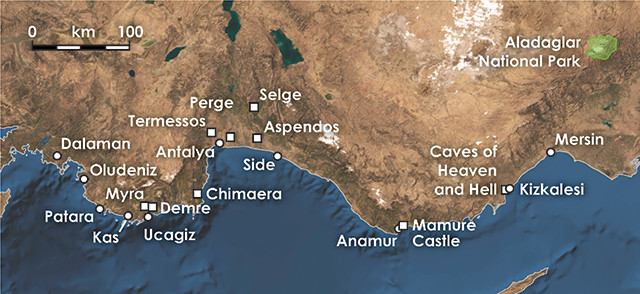
The Turquoise Coast runs 500 kilometers along Turkey's Mediterranean coastline. Credit: map: K. Cantner, AGI.
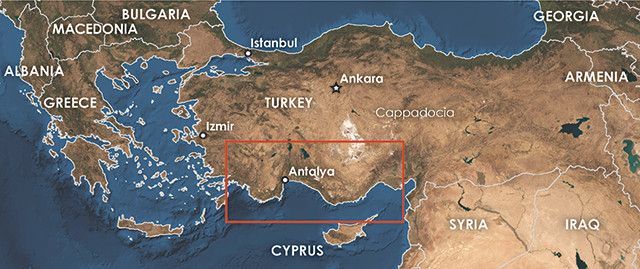
Area surrounding Turkey's Turquoise Coast. Credit: map: K. Cantner, AGI.
The Turquoise Coast stretches for more than 500 kilometers from Anamur in the east to the area around Bodrum, where the Aegean Sea blends into the Mediterranean. The region owes its breathtaking scenery to the complex tectonic plate boundary on which it lies. Here, the Anatolian Microplate is moving to the west, escaping the vice-like collision occurring between the much larger African and Eurasian plates. This collision, which closed most of the ancient Tethys Sea beginning in the Late Cretaceous, appended multiple tectonic fragments, known as terranes, to the Turkish continental margin. Bits of oceanic crust and underlying mantle, called ophiolites, typically mark ancient sutures. The collision zone’s enormous compressional forces heaped the area’s rocks into a series of giant recumbent folds, which stack atop one another like giant breaking waves. After the last terrane collision, the area subsided beneath the sea, allowing Miocene-aged marine limestone to be deposited on top of the contorted folds.
The region re-emerged above the Mediterranean waves about 8 million years ago when the Taurus Mountains were uplifted. By that time, the Anatolian Microplate’s westward motion was being accommodated by two major strike-slip faults, the North Anatolian and East Anatolian, which bound the fertile Anatolian Plateau to the north and southeast, respectively. (These faults are active today, posing the greatest natural hazard to Istanbul and other areas of Turkey.) Several other important strike-slip faults form subsidiary splays off the two main ones. Although these splays mainly accommodate the horizontal sliding characteristic of strike-slip faults, many of them also feature a small component of compression (this combination is called transpression), which causes crustal thickening. The individual sub-ranges within the sprawling Taurus mountain chain have been raised where transpression has occurred.
Ultimately, these tectonic contortions have created a landscape that is both spectacular and geographically complex. We couldn’t wait to explore the myriad impressive ruins left behind by the many Mediterranean civilizations that have called the Turquoise Coast home.
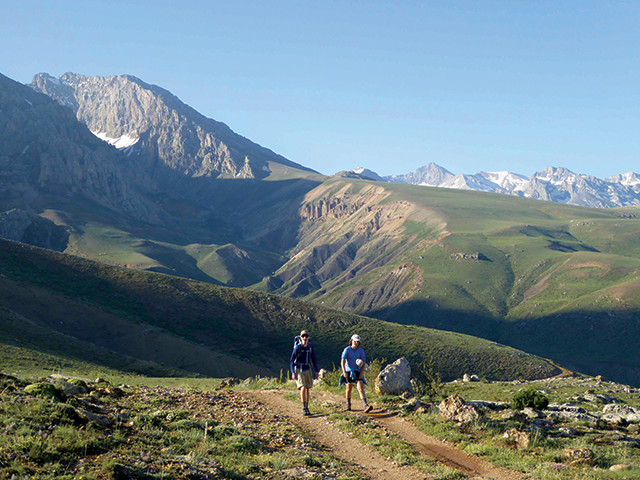
The Taurus Mountains, which begin in central Turkey, are a good jumping-off point for a visit to the Turquoise Coast. Credit: Terri Cook and Lon Abbott.
We began our adventure close to the Cappadocia region, a bit inland from the Turquoise Coast, in the heart of the impressive Taurus Mountains: the Aladaglar Range. There, transpression along the Ecemis Fault raised the towering limestone peaks of the Aladaglar to a lofty 3,700 meters, making it the highest of the Taurus ranges and the centerpiece of Aladaglar National Park. An ice cap there during the Pleistocene fed glaciers up to 17 kilometers long that carved the range’s deep, U-shaped valleys that today are studded with alpine lakes. Several premier trekking routes loop through the range’s alpine grandeur, and rock climbers flock to the range to test their skills on the steep walls of Tethyan limestone.
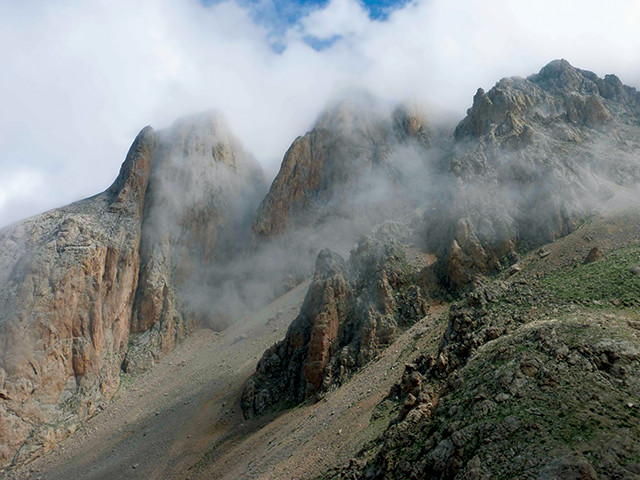
The limestone peaks of the Aladaglar Range, which rise to 3,700 meters, are the highest peaks in the Taurus Mountains. Credit: Terri Cook and Lon Abbott.
We stayed in a tiny village called Cukarbag, where we settled into a cozy cabin at the Aladaglar Camping Bungalow run by two climbers who know every trek and every rock climb in these mountains. Their expertise helped us organize several delightful days of trekking through the stark limestone landscape.
From Cukarbag, we headed south to the easternmost portion of the rugged Turquoise Coast, which, similar to Italy’s Amalfi Coast, is marked by a beautiful drive that traverses pine-covered hills and precipitous gorges. The pass from interior Turkey through the Taurus Mountains, known as the Cilician Gates, has historically been a strategic choke point. The town that guards its southern entrance, Mersin (ancient Yumuktepe), dates to 4500 B.C., making it one of the world’s oldest fortified settlements. Travelers and armies have passed through the gates for millennia, including such luminaries as Alexander the Great and Saint Paul.
Once we reached the Mediterranean Sea, the Caves of Heaven and Hell, a few kilometers west of Mersin, were our first destination. Both are massive sinkholes formed by dissolution of the Turquoise Coast’s abundant limestone bedrock. You can marvel at the 120-meter-deep Pit of Hell from a platform built out over the abyss. According to legend, Zeus imprisoned the fire-breathing monster Typhon in this pit after vanquishing him in battle. You can also descend into the Chasm of Heaven down 450 treacherously slippery steps, passing a fifth-century Byzantine chapel en route. In the Cave of Typhon, the deepest part of the chasm, we heard an eerie sound, like the gurgling of a river, making it easy to understand why the legendary River Styx is said to begin on the other side of the cavern’s limestone walls.
Just west of the caves, the rugged coastline bulges southward, reaching toward the island of Cyprus. Along this coast, in A.D. 1080, Armenians fleeing the Turkish advance on the crumbling Byzantine Empire founded the Kingdom of Cilicia (Lesser Armenia) amid the relative sanctuary of the coastal mountains. Cilician science and culture thrived in the succeeding centuries, and the Cilicians built a series of stout castles that later served as safe havens for Christian armies on their journeys east during the Crusades.
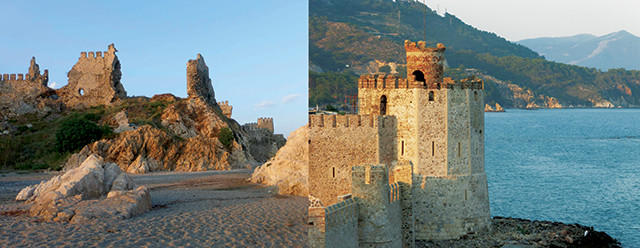
The 13th-century Mamure Castle still has 39 towers and an intact moat, making it the largest of the many Cilician fortresses along the Turquoise Coast. Credit: both: Terri Cook and Lon Abbott.
“We passed castle after castle along the drive. Kizkalesi, the Maiden’s Castle, is particularly noteworthy, as it was built on a shallow reef about 300 meters offshore, making for an unusual and striking vista. We camped one night near Anamur, amid palm trees fronting a beach that is one of about a dozen nesting sites along this coast for endangered loggerhead turtles. Next to the campground was the 13th-century Mamure Castle, whose 39 towers and intact moat make it the biggest and best preserved of the many Cilician fortresses.
West of Anamur, we followed the winding coastal road as it rose and fell from ridge to ravine along the rugged coastline. This area has an especially dense concentration of spectacular Roman ruins; it would take months of dedicated travel to see them in their entirety. One great spot is the coastal town of Side, where five of the Temple of Apollo’s second-century B.C. columns have been reconstructed on their original beachfront site. Side was where our kids got their first taste of Turkish ice cream — which, much like gelato in Italy, became their food of choice for the rest of the trip.
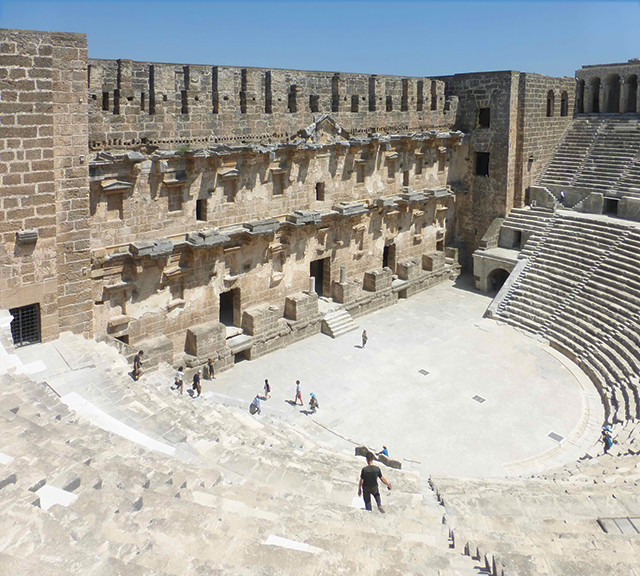
Built in A.D. 155, the Roman amphitheater at Aspendos, which seated 7,000 people, is one of the best preserved in the world. Credit: Terri Cook and Lon Abbott.
Also well worth visiting is nearby Aspendos, the location of one of the world’s best-preserved Roman theaters. It was an amazing site that left us hungry to view more historical ruins, but time constraints and our children’s pleas that they were “historied-out” forced us to pass by the world-class ruins of Selge, Perge and Termessos.
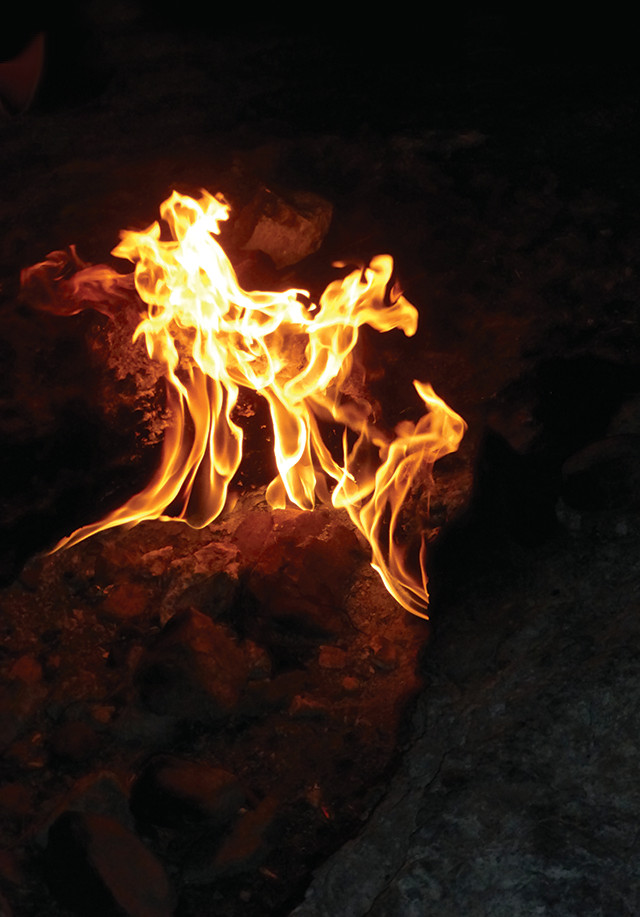
The Chimaera's eternal flames have been glowing for more than two millennia, thanks to natural chemical reactions that create methane as ultramafic rock weathers. It is here that the legend of the Chimaera — a fire-breathing lion-headed, goat-bodied, snake-tailed beast — was born. Credit: Terri Cook and Lon Abbott.
We continued along the coastal road, heading west toward Lycia, a southward-protruding peninsula between the modern cities of Dalaman and Antalya. South of Antalya, our first stop in Lycia was at the eternal flame of the Chimaera, near the beach town of Cirali. At dusk we began the 20-minute uphill hike to an outcrop of ophiolite that marks one of Turkey’s many terrane sutures. Natural chemical reactions that occur as the ophiolites’ ultramafic rock is weathered produce more than 150 tons of methane gas each year. The gas seeps to the surface at a couple dozen vents, where, for more than two millennia, it has fed natural “eternal” flames that are mesmerizing as night sets in.
© 2008-2021. All rights reserved. Any copying, redistribution or retransmission of any of the contents of this service without the expressed written permission of the American Geosciences Institute is expressly prohibited. Click here for all copyright requests.